Intel Core i7 3960X (Sandy Bridge E) Review: Keeping the High End Alive
by Anand Lal Shimpi on November 14, 2011 3:01 AM EST- Posted in
- CPUs
- Intel
- Core i7
- Sandy Bridge
- Sandy Bridge E
No Integrated Graphics, No Quick Sync
All of this growth in die area comes at the expense of one of Sandy Bridge's greatest assets: its integrated graphics core. SNB-E features no on-die GPU, and as a result it does not feature Quick Sync either. Remember that Quick Sync leverages the GPU's shader array to accelerate some of the transcode pipe, without its presence on SNB-E there's no Quick Sync.
Given the target market for SNB-E's die donor (Xeon servers), further increasing the die area by including an on-die GPU doesn't seem to make sense. Unfortunately desktop users suffer as you lose a very efficient way to transcode videos. Intel argues that you do have more cores to chew through frames with, but the fact remains that Quick Sync frees up your cores to do other things while SNB-E requires that they're all tied up in (quickly) transcoding video. If you don't run any Quick Sync enabled transcoding applications, you won't miss the feature on SNB-E. If you do however, this will be a tradeoff you'll have to come to terms with.
Tons of PCIe and Memory Bandwidth
Occupying the die area where the GPU would normally be is SNB-E's new memory controller. While its predecessor featured a fairly standard dual-channel DDR3 memory controller, SNB-E features four 64-bit DDR3 memory channels. With a single DDR3 DIMM per channel Intel officially supports speeds of up to DDR3-1600, with two DIMMs per channel the max official speed drops to 1333MHz.
With a quad-channel memory controller you'll have to install DIMMs four at a time to take full advantage of the bandwidth. In response, memory vendors are selling 4 and 8 DIMM kits specifically for SNB-E systems. Most high-end X79 motherboards feature 8 DIMM slots (2 per channel). Just as with previous architectures, installing fewer DIMMs is possible, it simply reduces the peak available memory bandwidth.
Intel increased bandwidth on the other side of the chip as well. A single SNB-E CPU features 40 PCIe lanes that are compliant with rev 3.0 of the PCI Express Base Specification (aka PCIe 3.0). With no PCIe 3.0 GPUs available (yet) to test and validate the interface, Intel lists PCIe 3.0 support in the chip's datasheet but is publicly guaranteeing PCIe 2.0 speeds. Intel does add that some PCIe devices may be able to operate at Gen 3 speeds, but we'll have to wait and see once those devices hit the market.
The PCIe lanes off the CPU are quite configurable as you can see from the diagram above. Users running dual-GPU setups can enjoy the fact that both GPUs will have a full x16 interface to SNB-E (vs x8 in SNB). If you're looking for this to deliver a tangible performance increase, you'll be disappointed:
| Multi GPU Scaling - Radeon HD 5870 CF | |||||
| Max Quality, 4X AA/16X AF | Metro 2033 (19x12) | Crysis: Warhead (19x12) | Crysis: Warhead (25x16) | ||
| Intel Core i7 3960X (2 x16) | 1.87x | 1.80x | 1.90x | ||
| Intel Core i7 2600K (2 x8) | 1.94x | 1.80x | 1.88x | ||
Modern GPUs don't lose much performance in games, even at high quality settings, when going from a x16 to a x8 slot.
I tested PCIe performance with an OCZ Z-Drive R4 PCIe SSD to ensure nothing was lost in the move to the new architecture. Compared to X58, I saw no real deltas in transfers to/from the Z-Drive R4:
| PCI Express Performance - OCZ Z-Drive R4, Large Block Sequential Speed - ATTO | ||||
| Intel X58 | Intel X79 | |||
| Read | 2.62 GB/s | 2.66 GB/s | ||
| Write | 2.49 GB/s | 2.50 GB/s | ||
The Letdown: No SAS, No Native USB 3.0
Intel's current RST (Rapid Story Technology) drivers don't support X79, however Intel's RSTe (for enterprise) 3.0 will support the platform once available. We got our hands on an engineering build of the software, which identifies the X79's SATA controller as an Intel C600:
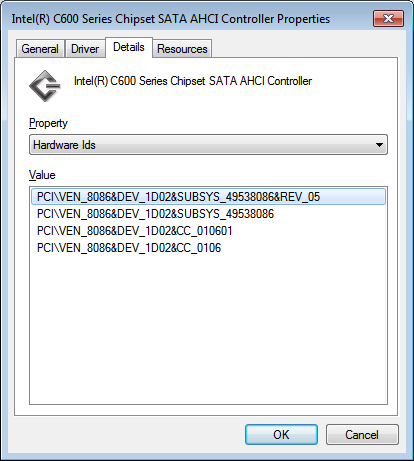
Intel's enterprise chipsets use the Cxxx nomenclature, so this label makes sense. A quick look at Intel's RSTe readme tells us a little more about Intel's C600 controller:
SCU Controllers:
- Intel(R) C600 series chipset SAS RAID (SATA mode)
Controller
- Intel C600 series chipset SAS RAID ControllerSATA RAID Controllers:
- Intel(R) C600 series chipset SATA RAID ControllerSATA AHCI Controllers:
- Intel(R) C600 series chipset SATA AHCI Controller
As was originally rumored, X79 was supposed to support both SATA and SAS. Issues with the implementation of the latter forced Intel to kill SAS support and go with the same 4+2 3Gbps/6Gbps SATA implementation 6-series chipset users get. I would've at least liked to have had more 6Gbps SATA ports. It's quite disappointing to see Intel's flagship chipset lacking feature parity with AMD's year-old 8-series chipsets.
I ran a sanity test on Intel's X79 against some of our H67 data for SATA performance with a Crucial m4 SSD. It looks like 6Gbps SATA performance is identical to the mainstream Sandy Bridge platform:
| 6Gbps SATA Performance - Crucial m4 256GB (FW0009) | ||||||
| 4KB Random Write (8GB LBA, QD32) | 4KB Random Read (100% LBA, QD3) | 128KB Sequential Write | 128KB Sequential Read | |||
| Intel X79 | 231.4 MB/s | 57.6 MB/s | 273.3 MB/s | 381.7 MB/s | ||
| Intel Z68 | 234.0 MB/s | 59.0 MB/s | 269.7 MB/s | 372.1 MB/s | ||
Intel still hasn't delivered an integrated USB 3.0 controller in X79. Motherboard manufacturers will continue to use 3rd party solutions to enable USB 3.0 support.


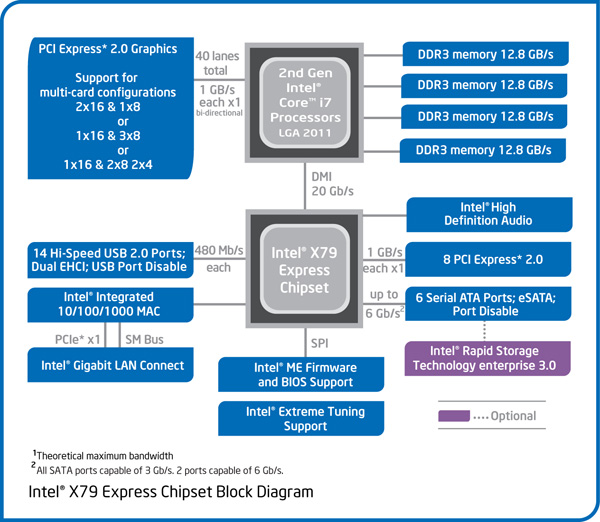
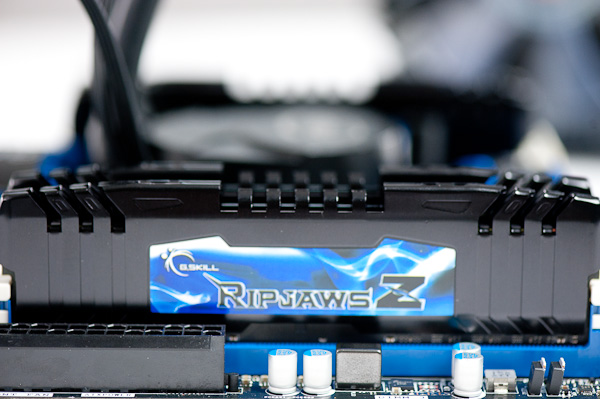
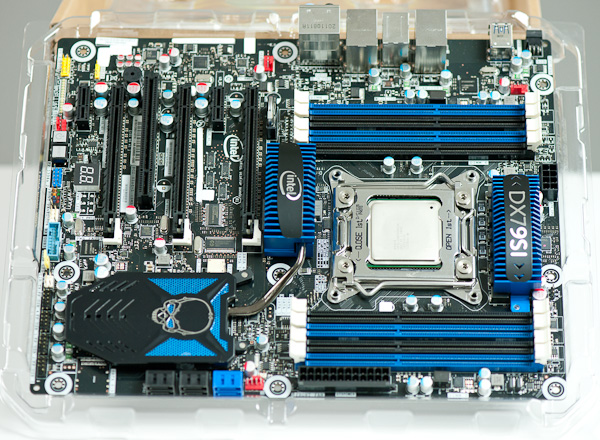
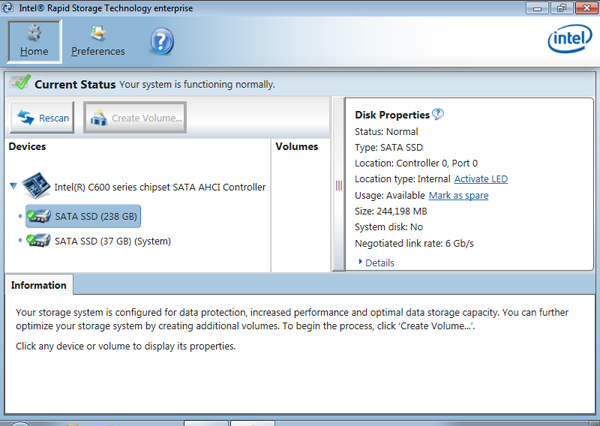








163 Comments
View All Comments
mino - Monday, November 14, 2011 - link
"Quick Sync leverages the GPU's shader array"This is simply not true. And you know it. Shame.
Steelski - Tuesday, November 15, 2011 - link
irrelevant CS4 test because someone buying this kind of hardware would appreciate the CS5 advantage other websites show.jewie27 - Tuesday, November 15, 2011 - link
I was waiting for X79 but after I read the initial reviews I bought a Z68 motherboard and 2500K cpu for gaming.C300fans - Tuesday, November 15, 2011 - link
Me too. 999$+X79 for 0% improvement in gaming. What a crab! Bulludozer seems not that crab comparing to 3960x overall.yankeeDDL - Tuesday, November 15, 2011 - link
Making unsubstantiated claims about something that is non-intuitive falls, in my dictionary, under fanboy-ism (if that's a word).The fact that Win7 "runs better" on a certain, relatively old, PC, is one thing. Stating that Windows7 is faster than XP (in spite of a documented benchmark proving otherwise) is another one.
Like I said, you can compare OS in terms of HW support, ease of use, even responsiveness, however, neither of those translate into one OS beinf "faster".
Faster means that when you run a benchmark (pick any of the ones that Anand run in this article), you get a noticeable increase in speed.
The OSes provide the infrastructure to run applications, they cannot provide any fundamental speed difference, unless, of course, you have a PC without enough RAM, for example, and in that case the OS that uses less RAM will have an obvious advantage (because it offers more "free" RAM for apps to run), but that again, has nothing to do with one OS being faster: if anything, it is more efficient.
I have 4GB on both my laptop (Win7) and on my desktop (WinXP) and the difference is negligible: I nearly always have more than 2GB of RAM committed, so it is no surprise that on your PC Win7 with ReadyBoost is faster: just spend ~$15 on 2GB of RAM and you'll see a huge performance improvement both on XP and 7.
jmelgaard - Tuesday, November 15, 2011 - link
So "Faster" must not apply to the OS's capability to respond to the user, it must only apply to the OS's capability to server application requests?...Wait what?...
Kob - Tuesday, November 15, 2011 - link
You guys need to look at the engineering of your requests: 6 sata3 ports require feeding 6*6gb/s = 36 Gb/s data, while the total max theoretical mem bw of the chipset is 37 Gb/s. Can't do that while also taking care of OS, apps and video memory requirements.cbutters - Monday, December 12, 2011 - link
6*6gb/s isn't going to be happening constantly.....you build out one bridge that has a certain amount of bandwidth, 12GB perhaps, I don't know, and let the ports use the available shared bandwidth, doesn't mean you can't add additional ports, this is one of the benefits of serial interfaces.C300fans - Tuesday, November 15, 2011 - link
Intel Gulftown 6C 32nm 6 1.17B 240mm2Intel Sandy Bridge E (6C) 32nm 6 2.27B 435mm2
SB-E, What a crab! Double Transistors, Double size, merely 20% gain from SB 2600k. 999$ for this? I would rather get 2 pcs Interlagos 6200 instead.
sna1970 - Tuesday, November 15, 2011 - link
using 5870 CF to show us that dual 8x PCIE are same as dula 16x is a mistake I am shocked some one like you fall in ...you should have tested 6990 in CF , or 590 ... and see the difference between 16x SLI/CF and 8x SLI/CF
and how do you consider a 5870 a MODERN GPU ?
Quote : "Modern GPUs don't lose much performance in games, even at high quality settings, when going from a x16 to a x8 slot."
Answer : WRONG . try high end dual GPU cards in SLI/CF !